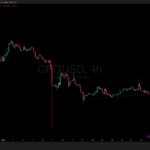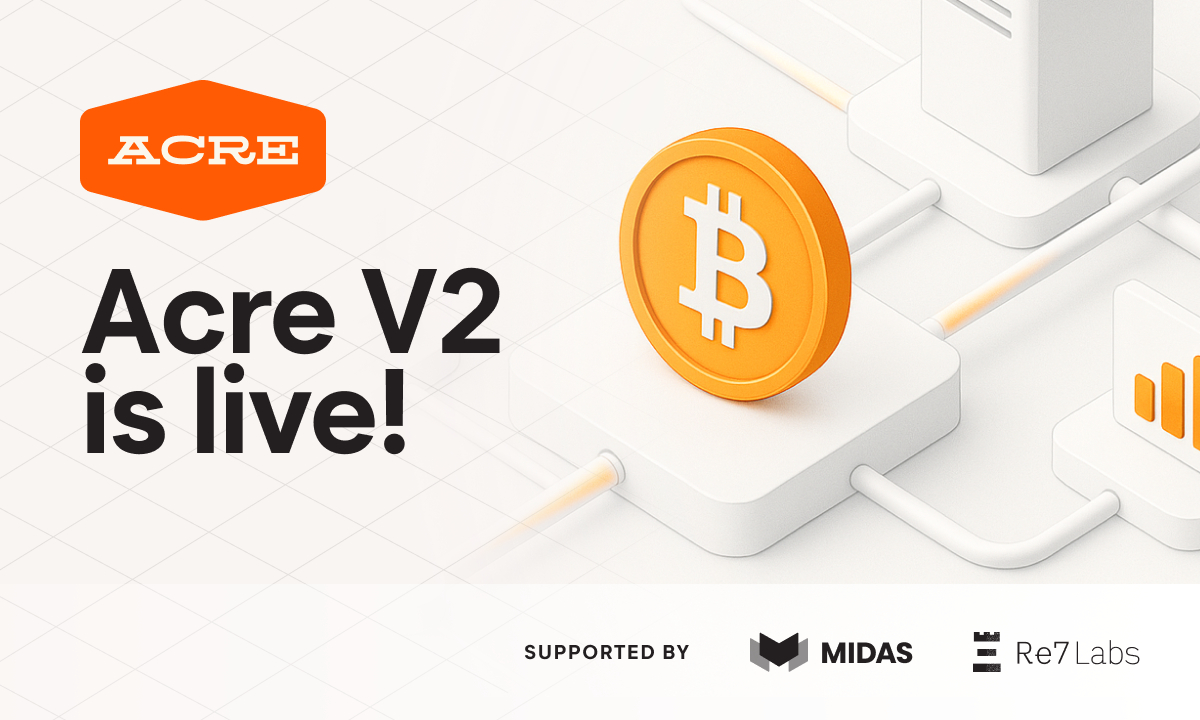MainnetLive Feed
Mainnet breaking news and instant alerts. Crypto Feed's minimalist interface delivers verified headlines, price movements, and protocol updates the moment they happen. Fast, focused, no fluff.
 5 Promising MegaETH Apps
5 Promising MegaETH AppsApps to explore before MegaETH's 'real-time Ethereum' mainnet goes live.
 Cronos Smarturn Upgrade Explained: Is CRO Price Set to Skyrocket?
Cronos Smarturn Upgrade Explained: Is CRO Price Set to Skyrocket?The much-anticipated Cronos Smarturn upgrade went live today, but the excitement was overshadowed by broader market volatility as the CRO price took a deep dive. Following the U.S. Federal Reserve’s 0.25bps rate cut on October 29, the crypto market turned red, with Bitcoin sliding below $110,000 and total market cap dipping about -2%. Historically, markets often correct after FOMC meetings before resuming their trend — and this time was no exception. Still, the broader outlook remains positive, with BTC holding above $105,000. $BTC liquidates and flush longs before the uptrend. Is this time different? pic.twitter.com/JV3TB0PXns — Crypto Seth (@seth_fin) October 30, 2025 That being said, Cronos was not spared. CRO price slipped 4.45% in the past 24 hours, closely tracking Bitcoin’s -3.6% and Ethereum’s -5%. Despite optimism surrounding the upcoming Smarturn upgrade, short-term pressure remains, with CRO trading near $0.143, down over 22% in the past month. With a key network milestone arriving amid macroeconomic uncertainty, traders now wonder: Can the Smarturn upgrade revive CRO’s rally, or will the bears stay in control? EXPLORE: 10+ Next Crypto to 100X In 2025 Macro Pressure: FED Rate Cut Triggers Crypto Selloff – Cronos Faces Resistance Amid Bearish Setup The FED’s 0.25bps rate cut initially triggered a wave of selling across crypto markets, and CRO price followed suit. On the 4-hour chart, the token is testing a key ascending support line near $0.142–$0.145, a level that has held since mid-October. (Source: Coingecko) If buyers fail to defend this area, the next stop could be $0.13, mirroring the September lows. The Relative Strength Index (RSI) hovers near 40, signaling fading momentum, while the MACD shows only mild bullish divergence — suggesting sellers still have the upper hand. DISCOVER: 16+ New and Upcoming Binance Listings in 2025 On the daily timeframe, CRO trades within a broad consolidation range between $0.118 support and $0.165 resistance. A decisive close above $0.165 would mark a short-term reversal, while slipping below $0.142 could confirm a deeper correction toward the $0.12 zone. EXPLORE: What is WET Token? Solana’s HumidiFi DEX to ICO in November – Next 100X Crypto? Technical Milestone for the Cronos Network – AI Expansion and ETF Potential Despite the bearish technicals, Cronos is taking a major step forward with today’s Smarturn mainnet upgrade, scheduled for block height 38,432,212 (around 7 A.M. GMT). The event introduces upgrades across the Ethereum Virtual Machine (EVM), IBC interoperability, smart accounts, and new opcodes, all aimed at improving scalability and developer performance. Users may experience a brief network downtime of up to one hour as validators finalize the transition. Once completed, Cronos aims for 30,000 transactions per second with 0.5-second block times, supporting faster DeFi and AI-driven applications. Beyond Smarturn, Cronos is also expanding its AI Agent SDK, allowing developers to create semi-autonomous on-chain agents for trading, cross-chain communication, and liquidity management — reinforcing Cronos’ ambition to become a hub for AI-powered blockchain ecosystems. Another potential long-term catalyst is ETF exposure. The Trump Media Crypto Blue Chip ETF is expected to allocate 5% to CRO, while Canary Capital’s staked CRO ETF awaits SEC review. Either approval could inject billions in institutional inflows, significantly boosting the CRO price and liquidity across the Cronos ecosystem. Do you believe $CRO will go past $1? There’s too much utility behind it.#CRO will be one of the biggest Blockchains in the world pic.twitter.com/9xjgEZ0MzL — Colin Chasmar Ⓥ (@CronosChaz) October 27, 2025 CRO Price Outlook: Consolidation Before Recovery? In the near term, CRO price remains at a critical support zone around $0.143. A rebound from this level could lift the token toward $0.16–$0.165, while a clean break above this resistance would confirm a potential move toward $0.21. Conversely, losing support could open the door for another test near $0.12. Despite the volatility, Cronos’ fundamentals remain strong. The network holds over $535 million in total value locked (TVL) and continues to expand its DeFi and AI integrations with partners like AWS and Google Cloud. If the Smarturn upgrade delivers improved performance and the broader market stabilizes, CRO price could see renewed momentum into late Q4 2025. EXPLORE: 9+ Best High-Risk, High-Reward Crypto to Buy in 2025 The post Cronos Smarturn Upgrade Explained: Is CRO Price Set to Skyrocket? appeared first on 99Bitcoins.
 Coinbase’s X402 Agentic Payments Network Will Power Global Economy By 2030
Coinbase’s X402 Agentic Payments Network Will Power Global Economy By 2030Just when you thought stablecoins alone were about to replace legacy payment processors charging ridiculous layered fees, news has emerged that the same Web2 interface can be enhanced to enable faster and cheaper payments. Folks in emerging economies have, for years, been forced to pay a premium when making international payments, but businesses and ordinary users can now breathe a sigh of relief with x402, an effort by Coinbase. Money runs the world, so they said. A June 2025 Grand View Research report forecasts the digital payment solutions market to cross the $361 billion mark by 2030. At this pace, it will grow at a rate of +21.4% CAGR between 2025 and 2030. (Source: Grand View Research) DISCOVER: 9+ Best High-Risk, High-Reward Crypto to Buy in 2025 Will x402 Bring Changes To Payment Processing? If so, will the X402 protocol play a big role in enabling smooth payments? To understand this and determine whether the tech stands a chance, it is essential to know what X402 enhances to qualify as a game changer. For starters, x402 is an initiative backed by Coinbase, the global exchange, that aims to create a web-native payment protocol that enables, among other things, AI agents and dapps to transact using stablecoins on any smart contracts-enabled platform. Ideally, dapps and AI agents using the x402 should run on scalable, low-fee networks, including Base or MegaETH, for example. In this way, all transactions will not only be executed instantaneously but fees will be so low that there will be no impact on the end user. There is no need for logins or KYC. With x402 gaining traction and a perfect scalable blockchain platform, which can be a native mainnet or layer-2, it is easy to see why the protocol, which is open source, can enable agentic commerce. Here, a swarm of AI agents can interlink, enabling autonomous payments for services, data, and more. DISCOVER: 16+ New and Upcoming Binance Listings in 2025 Will x402 Power Global Economy By 2030? And there are signs that this is where everything is headed. Two things are here to stay: Stablecoins and AI. It took years before stablecoins found mainstream adoption and regulatory endorsement. Meanwhile, AI was received with open arms right after the first iteration went live. The explosion of OpenAI and ChatGPT proved how useful this technology is, explaining the multi-billion-dollar investments by titans, including Meta and Microsoft. If convenient, trustless, and open payment is the name of the game going forward, it is easy to see why x402 will be a go-to protocol. A16z Crypto projects that autonomous transactions could cross the $30T mark by 2030. As such, if x402 becomes the choice platform and evolves to be the backbone for AI-to-machine payments, there is little doubt that it would effectively restructure a large portion of the internet’s business model. Trackers show that x402-powered transactions now total over 3.1M, generating over $3.5M in volume. Of this, there are over 162,000 buyers and 30,000 sellers. (Source: x402 Scan) With more adoption, developers will look to enhance the open source protocol. This, in turn, will draw more partners. Founding developers include Cloudflare and Coinbase, but in recent months, the tech has found support from Google. It signals strong tech industry backing as the drive for adoption and standardization grows. DISCOVER: 10+ Next Crypto to 100X In 2025 Coinbase x402 To Power Global Economy By 2030? Coinbase x402 is an open-source protocol x402 finding rapid global adoption AI explosion is fueling more developments of agents Will x402 power the global economy by 2030? The post Coinbase’s X402 Agentic Payments Network Will Power Global Economy By 2030 appeared first on 99Bitcoins.
 Ethereum’s Fusaka Upgrade Hits Final Testnet – Mainnet Launch Locked for December 3
Ethereum’s Fusaka Upgrade Hits Final Testnet – Mainnet Launch Locked for December 3Ethereum’s much-anticipated Fusaka hard fork reached a major milestone on Tuesday with a successful deployment on the Hoodi testnet – its final testing phase before mainnet activation later this year. The test, which went live around 18:53 UTC, was the completion of Ethereum’s three-stage simulation process following earlier activations on the Holesky and Sepolia testnets. Fusaka Upgrade According to the Ethereum Foundation, Fusaka’s mainnet rollout is expected at least 30 days after Hoodi’s activation, while developers tentatively target December 3. The main objective behind the upgrade is to strengthen Ethereum’s scalability, security, and cost efficiency, building on the groundwork laid by April’s Pectra upgrade. Fusaka introduces a series of technical improvements spanning more than a dozen Ethereum Improvement Proposals (EIPs). Leading the list is the EIP-7594, or Peer Data Availability Sampling (PeerDAS), which enables validators to verify only portions of data, rather than entire “blobs,” and significantly reduces bandwidth demands and operational costs for validators and Layer 2 networks. Other proposals, such as EIPs 7825 and 7935, will adjust gas limits to improve efficiency and prepare the network for parallel execution, while EIPs 7939 and 7951 boost performance and zero-knowledge proving support. These upgrades are designed to lower transaction costs for users and developers while setting the stage for the next phase of rollup scaling. Ethereum client teams confirmed smooth progress following Hoodi’s activation. Nethermind stated “The Ethereum 𝗛𝗼𝗼𝗱𝗶 𝗙𝗼𝗿𝗸 has been successfully completed and is now running seamlessly on the 𝗡𝗲𝘁𝗵𝗲𝗿𝗺𝗶𝗻𝗱 𝗖𝗹𝗶𝗲𝗻𝘁. Another smooth upgrade, another key milestone on the road to Fusaka. Big thanks to everyone in the ecosystem who helped make it happen – from client teams to researchers and operators.” Road Ahead Consensys also said that Fusaka “paves the way for parallel execution” and lays the foundation for future network advancements. The rollout will proceed in phases. Following the mainnet launch scheduled for December 3, blob capacity increase is expected to be on December 17, while a second hard fork to expand blob capacity further is slated for January 7, 2026. Ethereum developers have already turned their focus to the next upgrade, dubbed “Glamsterdam,” which is expected to introduce faster block times and further scalability enhancements. Glamsterdam falls under the “Surge” stage of the network’s roadmap. Meanwhile, ETH’s price remained fairly unfazed by the technical development. The altcoin recorded a fresh decline of almost 3% over the past 24 hours and is currently trading below $4,000. The post Ethereum’s Fusaka Upgrade Hits Final Testnet – Mainnet Launch Locked for December 3 appeared first on CryptoPotato.
 Acre Launches V2 Platform, Enabling Bitcoin Holders to Earn 14% APY (est.) from Self-Custody
Acre Launches V2 Platform, Enabling Bitcoin Holders to Earn 14% APY (est.) from Self-Custody[PRESS RELEASE – New York, NY, October 29th, 2025] By enabling BTC to earn a sustainable yield right from their Bitcoin wallet, Acre sets a new standard for decentralized, transparent Bitcoin finance. Acre, a Bitcoin-first platform that enables BTC holders to compound their coins while maintaining self-custody, today announced the launch of its estimated 14% APY vault, a significant step toward transforming Bitcoin from a passive store of value into a productive asset. Bitcoin holders can participate directly from their wallets, without the complexity of DeFi bridging and without sacrificing self-custody. The Acre Security Council vets all strategies, and all rewards are automatically converted back to native Bitcoin. Bridging (via tBTC), rebalancing, and reinvesting gains are all handled automatically onchain by the protocol. This approach not only empowers users but also brings vital liquidity to protocols and builders reimagining finance built around Bitcoin. Key features include: Self-Custodial: Users retain full control of their BTC at all times. Sustainable Rewards: Acre vaults employ time-tested, onchain yield sources. BTC Rewards Only: All rewards are paid directly in Bitcoin, no exposure to unfamiliar tokens or chains. Auto-Compounding: Acre automatically reinvests BTC earnings for maximum growth. Acre’s first vault, estimated 14% APY, is curated by Re7 Labs, with vault infrastructure provided by Midas, two trusted leaders in DeFi automation and vault management. Previously only available to institutions and high-net-worth individuals, the strategy includes a portfolio of time-tested techniques (liquidity provision, options, L2 staking) with Re7’s industry-best approach to risk management. Each Acre vault must meet strict risk management criteria and undergo review and approval by the Acre Security Council, ensuring robust oversight and transparency. The Council includes executives and members from Lido, Anagram, LedgerPrime, and Threshold. More information can be found in the Acre Deployment Policy. “Today, Bitcoin holders are forced to choose between giving up control to a custodian or navigating all the complexity of DeFi—bridging, vault rotation, rebalancing, and selling off altcoins–often for barely 1% in yield,” said Laura Wallendal, CEO of Acre. “Acre removes that tradeoff by providing a secure, transparent way to earn compounding yield on BTC, without the custodial risk or typical DeFi complexity.” “The team at Acre has taken a comprehensive approach to building a yield platform rooted in transparency, risk management, and strong governance,” said Evgeny Gokhberg, Founder & CIO at Re7 Capital. “Together, we’re advancing institutional DeFi infrastructure, with this launch marking a key step on Ethereum Mainnet and expanding access to BTC yields within DeFi.” “Acre has taken a collaborative approach, giving BTC holders access to potential earning opportunities while maintaining strong transparency and operational safeguards,” Dennis Dinkelmeyer, CEO of Midas. “Responsible partnerships like this are key to building user confidence and supporting the growth of onchain financial products.” According to recent research, 73% of Bitcoin holders are interested in earning yield, but more than 40% would allocate less than 20% of their holdings to BTCFi products due to concerns around trust and complexity. Acre directly addresses this gap by combining transparent onchain infrastructure with oversight through the Acre Security Council. About Acre Acre is a Bitcoin-first platform that helps BTC holders compound their bitcoin while maintaining full control of their assets. By connecting bitcoin to decentralized protocols like lending, insurance, and Bitcoin layer 2 networks, Acre creates a seamless way for users to compound their bitcoin without complexity or the risk from centralized custodians. Founded by the team behind projects like Fold, Casa, Thesis, and tBTC, and supported by leaders at Lido, Eigenlayer, Midas and Re7, Acre brings over a decade of Bitcoin expertise with a focus on simplicity and transparency. To learn more about how Acre is compounding bitcoin, users can visit https://acre.fi. The post Acre Launches V2 Platform, Enabling Bitcoin Holders to Earn 14% APY (est.) from Self-Custody appeared first on CryptoPotato.
 ENA Jumps 4% as First Ethena-Native DEX Ethereal Launches Mainnet Alpha
ENA Jumps 4% as First Ethena-Native DEX Ethereal Launches Mainnet AlphaEthereal, the spot and perpetual futures DEX approved by Ethena community governance, announced in a Tuesday X thread that its mainnet alpha is now live, and a small group of users can start trading with USDe, a synthetic dollar stablecoin by Ethena Labs.First proposed to Ethena governance last year, Ethereal is described as the “only perps DEX building a complete all-in-one DeFi money app around USDe,” according to the project’s documentation. Under that plan, ENA holders are set to receive 15% of any future Ethereal token, tying the exchange’s growth directly to Ethena’s token economy.To continue reading this as well as other DeFi and Web3 news, visit us at thedefiant.io
 Ethereum Foundation Announces Gas Limit Cap for Upcoming Fusaka Upgrade
Ethereum Foundation Announces Gas Limit Cap for Upcoming Fusaka UpgradeThe Ethereum Foundation (EF) has announced a change to the upcoming Fusaka hard fork that will introduce a per-transaction gas limit cap.The EF unveiled the change via its blog today, with the update, also known as EIP-7825, already live on the Holesky and Sepolia testnet networks. EIP-7825 is expected to launch on the Ethereum mainnet when Fusaka goes live in December.Currently, a single transaction can fill an entire block's 45 million gas limit, which could inhibit parallel execution and open the door to Denial of Service (DOS) attacks. The change will set a per-transaction gas limit of 16.78 million to mitigate potential issues.To continue reading this as well as other DeFi and Web3 news, visit us at thedefiant.io
